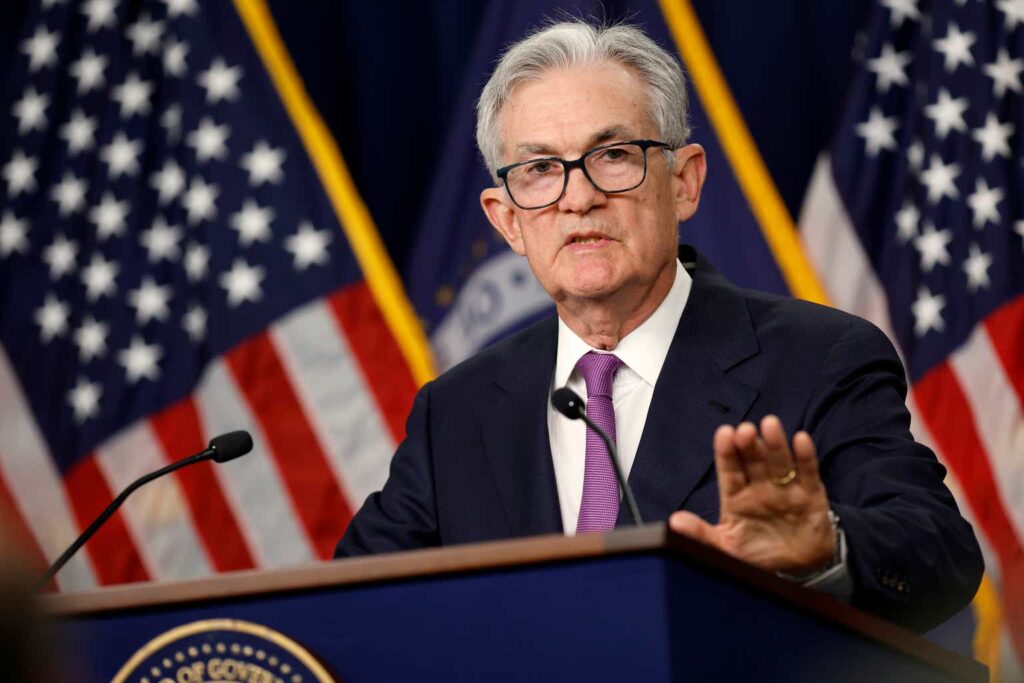The volatility we have seen in the market over the past few weeks may only grow worse.
There will be a lot of data coming this week, and if there is one day you don’t want to miss, it will be Wednesday. It will be a special day filled with a plethora of data releases, all at varying times, starting with the ADP Jobs Report, followed by the JOLTS and ISM, and then the FOMC rate decision, concluding with the highlight of the day, the Jay Powell press conference. The only thing missing is another hold-your-breath moment at 1 PM ET for a Treasury auction, which has become a much-watched event.
The market assigns a 0% chance of a rate hike on Wednesday from the Fed and very low odds for another rate hike anytime soon. And while the Fed probably won’t raise the rate this week, it seems pretty clear that the purpose of the special Jay Powell interview two weeks ago was to make it clear that if the Fed doesn’t hike, one should not think the Fed is done. I would expect that Jay Powell will continue to send that message in the statement and at the press conference.
Risks For More Hikes Is Present
The Fed has to remain open to further rate hike possibilities because the economic data continues to support the notion there may need to be more done to slow the economy enough to bring inflation back to target. While a 3.4% headline PCE inflation rate is far better than 7%, it is still far from 2%.
Bloomberg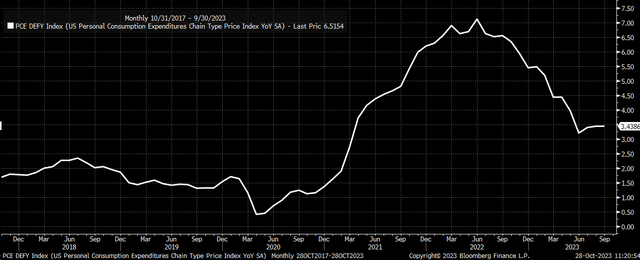
Additionally, the US economy grew in the third quarter by 4.9% on a quarter-over-quarter seasonally adjusted annualized rate. That was the fastest rate since the fourth quarter of 2021, which was well before the first rate hike of the cycle. To make matters worse, from the Fed’s point of view, GDP growth has been getting stronger since it bottomed in the first quarter of 2022, when the Fed raised rates for the first time.
Bloomberg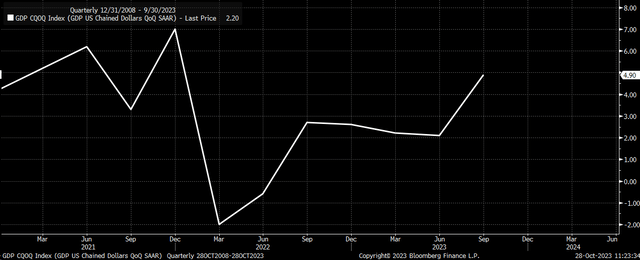
Even more impressive about that GDP print was that the GDP price index rose by 3.5%, too, which means that nominal growth in the third quarter advanced to 8.5%. More surprising is that all of this growth has come this late in the cycle, with the Fed Funds rate rising from 0% to an effective funds rate of 5.33%.
Bloomberg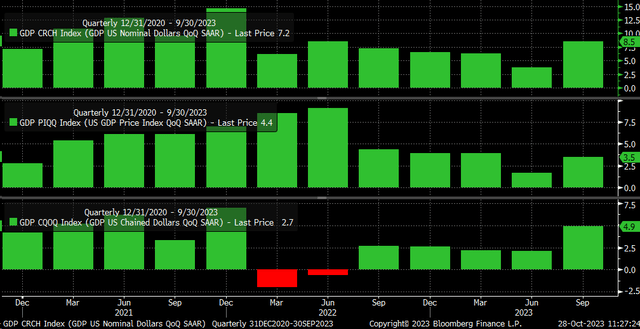
Leaving The Door Open
Given this data, it will be hard for the Fed to signal that it is done raising rates; if anything, it will need to leave the door open to more rate hikes until there are clear signs that inflation is on a consistent trend to 2%. Even the super core PCE reading increased by 0.42% m/m in September, and on a 12-month moving average, it is at 0.35% and is extremely volatile, making it hard to determine if that inflation rate is moderating. That moving average remains well above the pre-pandemic measures and certainly doesn’t seem to show much, if any, moderation.
Bloomberg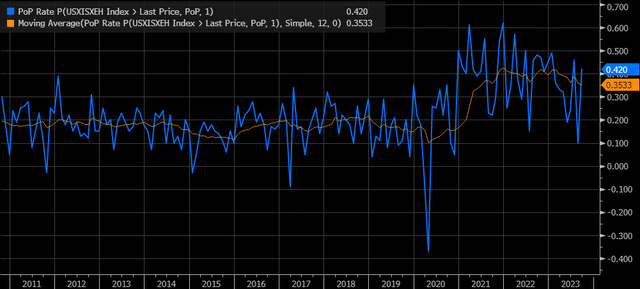
What makes this measure of inflation worse is that it appeared the rate of change was slowing when measuring it in 3-month increments, with the fourth quarter of 2022 annualized rate of 5.4%, dropping to 3.01% in the second quarter of 2023. However, that accelerated in the third quarter of 2023 to 3.94%. So, the disinflationary trend ended with the reacceleration in the broader economy.
Bloomberg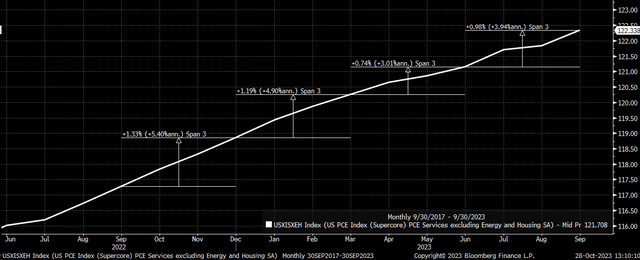
This will leave the Fed in the same spot it was just two weeks ago when Jay Powell must have said “we’ll have to see” on multiple occasions and left open the possibility that policy isn’t sufficiently restrictive enough. To make things even more challenging for the Fed, the data for October may be just as strong as the data we saw coming out of September. The preliminary data point seen in the S&P Global PMIs showed that both services and manufacturing turned higher in October. Now, the ISM data doesn’t always agree month by month with the S&P Global data points, but over time, they tend to trend the same, and both seem to be showing a turn higher since the summer.
Bloomberg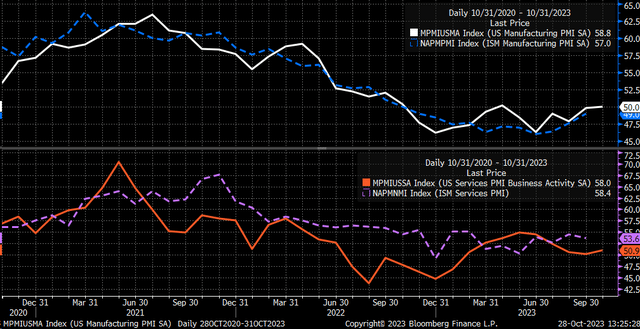
Meanwhile, the Indeed job posting data may have come off its high, but it shows that the number of job openings has stabilized and stopped falling in recent months, and suggests that the JOLTS, while extremely volatile, is subject to massive revisions and hard to predict, should to some degree show some of that same basing effect.
St. Louis Fed
Continuing claims have ticked higher but are still well below where it was in April, and that likely signals there isn’t going to be much if any, changes in the unemployment rate when that is reported on Friday.
Bloomberg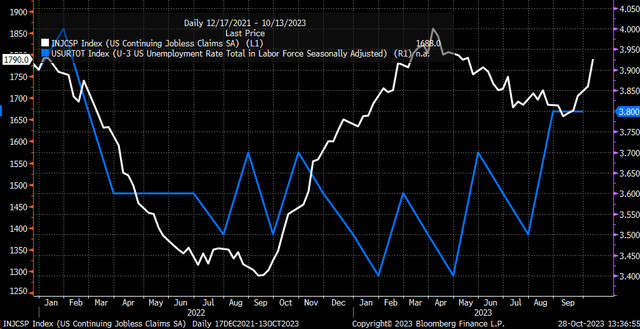
Not Restrictive Enough
With the economy still showing signs of being resilient, the evidence would suggest that the lags of monetary policy are even longer than some thought or that the effects of monetary have already been felt, and rates aren’t restrictive enough.
Given that monetary policy works through changes in financial conditions and that financial conditions have eased dramatically over the past six months, it would seem that policy is not restrictive enough. The Bloomberg financial condition model shows that financial conditions have only started to tighten since the middle of October but had been eased starting at the beginning of June.
Bloomberg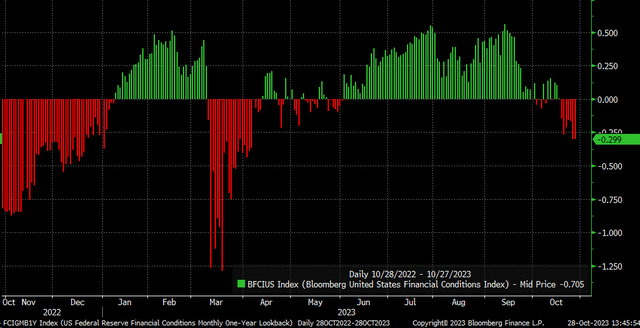
The Chicago Fed Financial conditions show that financial conditions eased dramatically after peaking in mid-March and then eased again in the middle of June.
Bloomberg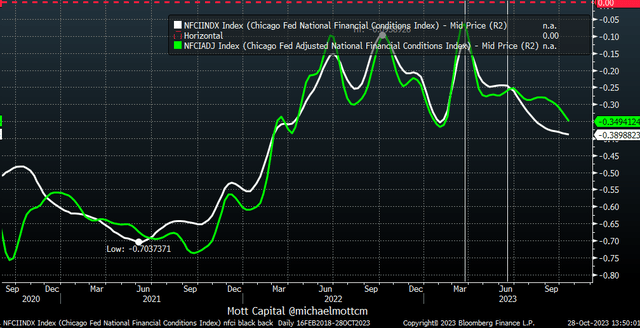
All of this occurred at the same time that the pace of inflation and the economy accelerated. This tells us that if the Fed’s policy is transmitted through changes in financial conditions, policy isn’t only restrictive enough; it has become accommodative to the economy.
At this point, the Fed has no choice but to keep iterating the message of two weeks ago. The Fed may still have to raise rates further, that policy may not be restrictive enough, and that rates may have to be held high for even longer.
The Market Can Look At Itself
Ultimately, credit spreads, stock prices, and the dollar determine whether financial conditions are tightening or easing. So when the market thinks that the Fed is done hiking following the collapse of SVB and the dollar plummets, financial conditions ease. When the stock market tries to front a Fed rate-cutting cycle 15 times over 18 months, financial conditions ease; when the market thinks that the Fed isn’t serious and rates on the long end of the curve fall, financial conditions ease.
So, seeing financial conditions ease the way they have, it isn’t surprising to see the Fed leaving the door open to more rate hikes. It isn’t surprising to see the economy and inflation reaccelerate.
The bottom line is that the market thought the Fed was done in March, which allowed credit spreads to contract, stocks to rally, and the dollar to plummet, which allowed the economy to accelerate.
Because of this reacceleration in the economy and the Fed’s guidance, the market has to catch up; bond yields have rocketed, the dollar has strengthened, credit spreads are widening, and the stock market is falling. It was only after the September FOMC meeting that the bond market got it. However, this also means it shouldn’t be surprising to see the economy slow over the next few months and bring recession risk back on the table for 2024, or worse, stagflation risk.
Bloomberg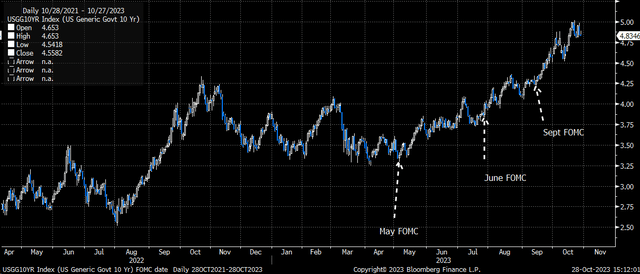
Perhaps this was part of the Fed’s master plan to bring the economy in for a soft landing, or it was by chance. Who knows, but for the Fed to get inflation down to 2%, then the volatility we are seeing in the stock market is going to get worse before it gets better.
Read the full article here


